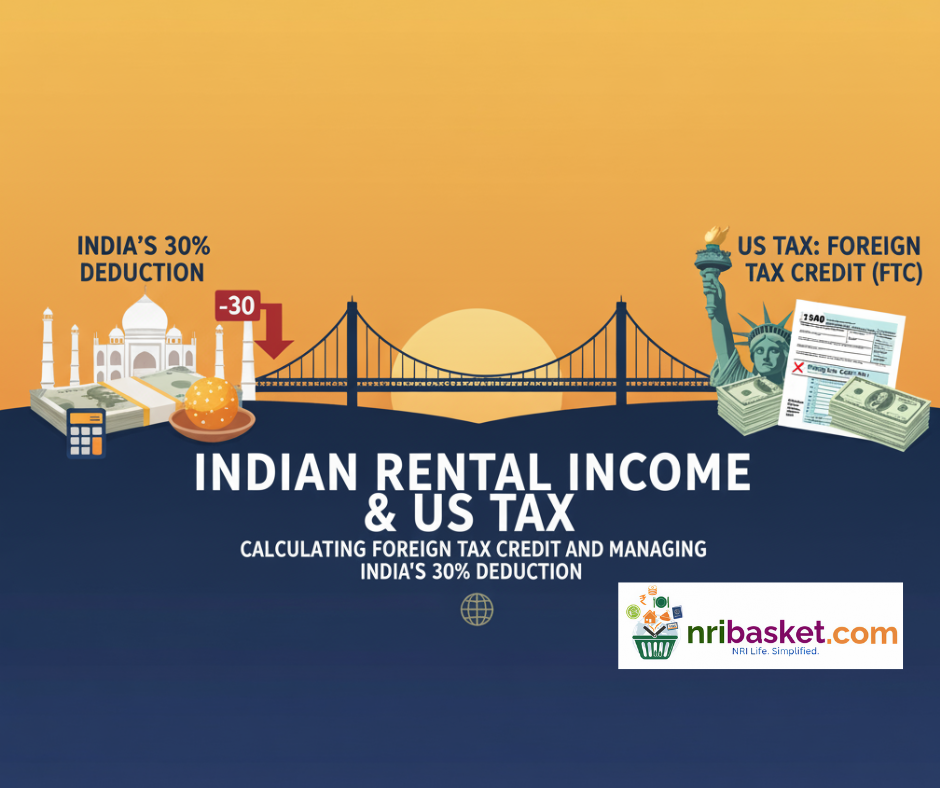
Indian Rental Income & US Tax
If you’re a US resident or NRI earning rent from property in India, understanding how it’s taxed in both countries can be confusing. India deducts a flat 30% standard allowance from rental income, while the US taxes global income, including rent from India. Thankfully, the India–US Double Taxation Avoidance Agreement (DTAA) and the Foreign Tax Credit (FTC) help you avoid paying tax twice.
In this guide, we’ll simplify how to report Indian rental income on your US tax return, calculate foreign tax credits, and manage India’s 30% deduction efficiently. Whether you’re filing as an individual or with a CPA, this article explains everything you need to stay compliant and save on taxes.
Long Answer: The United States taxes its residents on worldwide income. If you earn rental income from property in India, it must be reported on your US tax return (Form 1040, Schedule E). You can claim a Foreign Tax Credit for taxes paid to India to avoid double taxation.
Long Answer: The Indian government allows a 30% standard deduction on the net annual value of the property. After this deduction and property taxes, the remaining amount is added to your total income and taxed according to your income slab rate in India.
Long Answer: Under Section 24(a) of the Indian Income Tax Act, you can claim a flat 30% deduction on the net annual value of the rented property, regardless of your actual expenses. This simplifies tax calculation and reduces your taxable rental income in India.
Long Answer: The US tax system follows its own depreciation and expense deduction rules. You cannot claim India’s 30% standard deduction in the US. Instead, you can deduct actual expenses such as property taxes, mortgage interest, insurance, and depreciation per IRS rules.
Long Answer: The Foreign Tax Credit allows you to offset US taxes with the income tax you already paid in India. This prevents double taxation. You must file IRS Form 1116 with your US return to claim this credit for Indian rental income.
Long Answer: You’ll need to convert your Indian tax payment to USD, allocate it to the same income category (general income), and compute the credit limit using IRS Form 1116. The credit cannot exceed the proportion of your US tax liability attributable to foreign income.
Long Answer: You must either claim the Indian taxes paid as a credit (preferred for most taxpayers) or as an itemized deduction. The credit provides a dollar-for-dollar reduction in US tax liability, so it is usually more beneficial than a deduction.
Long Answer: The IRS allows using the annual average exchange rate for the relevant tax year to convert Indian rupees to US dollars. You can find official rates on the IRS or US Treasury websites. Keep documentation for your records.
Long Answer: You’ll report your Indian rental income and expenses on Schedule E (Supplemental Income). If you paid tax in India, also complete Form 1116 to claim the Foreign Tax Credit. These forms attach to your annual Form 1040 return.
Long Answer: The IRS allows depreciation on foreign rental property over 30 years (straight-line method). You must calculate the building’s value in USD and depreciate only the structure, not the land. This can reduce your taxable income in the US.
Long Answer: The IRS requires all US residents to report global income. Failing to disclose Indian rental income can lead to penalties, back taxes, and possible audits. It may also affect your ability to claim the Foreign Tax Credit later.
Long Answer: Income from property situated in India is always taxable in India, regardless of where you live. You must file an Indian income tax return if your total income in India exceeds the basic exemption limit. The US tax return then includes that income with an FTC claim.
Long Answer: Maintain records like rent agreements, bank statements showing rent deposits, Form 26AS (for TDS), and proof of Indian tax paid. These documents support your US tax filings and help calculate the Foreign Tax Credit accurately.
Long Answer: Non-resident landlords often have TDS (tax deducted at source) applied to rent payments by tenants in India. You can claim this amount as Indian tax paid when filing both your Indian and US tax returns to avoid double taxation.
Long Answer: India and the US have a Double Taxation Avoidance Agreement (DTAA). This allows you to pay taxes first in India, then claim a credit in the US for the same income, reducing or eliminating duplicate taxes.
Long Answer: The 30% deduction under Indian law is a flat allowance for repairs and maintenance. Depreciation, on the other hand, spreads the property’s cost over time for tax purposes. The 30% rule is simpler and automatic in India.
Long Answer: The IRS allows you to deduct mortgage interest as an expense against rental income, even for properties located outside the US. This must be reported on Schedule E along with other related expenses.
Long Answer: Property taxes paid to Indian authorities are considered an allowable expense under US tax law. You can include them in your Schedule E deductions for maintaining the rental property.
Long Answer: The US tax system taxes worldwide income regardless of whether you transfer the money to the US or keep it in India. The source or location of funds doesn’t change the tax reporting requirement.
Long Answer: The 30% standard deduction in India is meant to cover repairs, maintenance, and upkeep. Therefore, you cannot claim any additional expenses under that head in India.
Long Answer: Convert Indian taxes paid into USD using the annual average exchange rate published by the IRS or the US Treasury. Consistency is important, so use the same method for both income and tax conversion.
Long Answer: If your Indian taxes exceed your US tax liability for that year, you can carry forward unused credits for up to 10 years or carry them back one year. This ensures maximum benefit from taxes paid abroad.
Long Answer: The Double Taxation Avoidance Agreement (DTAA) allows residents to avoid paying taxes twice on the same income. It outlines which country has taxing rights and provides credits or exemptions for foreign income.
Long Answer: Mention the TDS amount deducted by the Indian tenant in the “Foreign Taxes Paid” section of Form 1116. Convert it to USD and attach proof (Form 16A or 26AS) for IRS verification if requested.
Long Answer: You can deduct rental losses from Indian property against other passive income in the US. However, if your income is high, these losses may be limited and carried forward until the property is sold or gains are realized.
Long Answer: Rental income from Indian property is taxable in India, even if rent is transferred directly to an overseas account. The income’s source, not its location, determines taxability under Indian law.
Long Answer: Real property doesn’t go on FBAR, but if the rent or tax is received or paid through Indian bank accounts and the total foreign balance exceeds $10,000, those accounts must be reported on FBAR (FinCEN Form 114).
Long Answer: The Indian 30% deduction doesn’t affect US depreciation rules. You can still depreciate the property under US law because the US and Indian systems operate independently. Just avoid double-counting the same expense.
Long Answer: If you receive an Indian tax refund for prior rental income, you must reduce the Foreign Tax Credit previously claimed in the US for that year. This can be corrected through an amended return or adjustment in the next filing.
Long Answer: Track rental receipts, Indian tax payments, and exchange rates. File returns in both India and the US, and claim the Foreign Tax Credit correctly. A CPA familiar with both systems can ensure compliance and maximize your tax benefits.
aBOVE POST HIGHLIGHTS US tax on Indian rental income, Indian rental income foreign tax credit, India 30% standard deduction, India house property tax US return, DTAA India USA rental income, Form 1116 foreign tax credit rental, Indian property income in US tax, rental income India US double taxation, NRI rental income tax, claim foreign tax credit India US, report Indian rent income on US tax return, US expat taxes India property, tax on Indian property income for US residents .
Have a question or want us to add your scenario?
Tell us what you need — we’ll update this guide and answer publicly so other NRIs can benefit. Your question may be featured in the next update.




